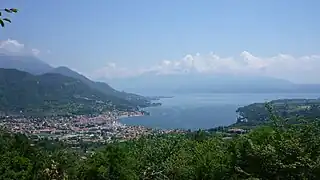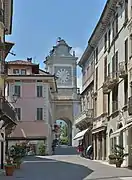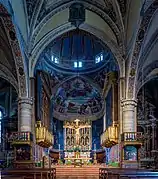Salò
Salò (Italian: [saˈlɔ]; Latin: Salodium) is a town and comune in the Province of Brescia in the region of Lombardy (northern Italy) on the banks of Lake Garda, on which it has the longest promenade. The city was the seat of government of the Italian Social Republic from 1943 to 1945, a state often referred to as the "Salò Republic" (Repubblica di Salò in Italian).
Salò | |
|---|---|
| Città di Salò | |
 View of Salò and its bay | |
Location of Salò | |
 Salò Location of Salò in Italy  Salò Salò (Lombardy) | |
| Coordinates: 45°36′30″N 10°31′00″E[1] | |
| Country | Italy |
| Region | Lombardy |
| Province | Brescia (BS) |
| Frazioni | Barbarano, Campoverde, Renzano, Villa, Cunettone, Serniga, San Bartolomeo, Moriondo |
| Government | |
| • Mayor | Giampietro Cipani (FI) |
| Area | |
| • Total | 29 km2 (11 sq mi) |
| Elevation | 65 m (213 ft) |
| Population (2017)[3] | |
| • Total | 10,576 |
| • Density | 360/km2 (940/sq mi) |
| Demonym | Salodiani |
| Time zone | UTC+1 (CET) |
| • Summer (DST) | UTC+2 (CEST) |
| Postal code | 25087 |
| Dialing code | 0365 |
| Patron saint | St. Charles |
| Saint day | 4 November |
| Website | Official website |
History
Roman period
Although legend has it that Salò has Etruscan origins, recorded history starts with the founding by ancient Romans of the colony of Pagus Salodium. There are numerous ruins of the Roman settlement, as shown by the Lugone necropolis (in via Sant’Jago) and the findings (vase-flasks and funeral steles) in the Civic Archaeological Museum located at the Loggia della Magnifica Patria.[4]
Middle Ages
During the high Middle Ages, the city shared the same history as that of Lombardy.
The origins of the municipality of Salò are barely known: its autonomy from Brescia can be dated towards the end of the 13th century or the beginning of the next one, and the most ancient statues conserved by the city authorities are dated 1397.[5]
Prior to 1334, the town was part of a sort of federation of town councils of the territory along the western lakeshore of Lake Garda (from Limone down to Desenzano) and the Valsabbia areas, called Riperia Lacus Gardae Brixiensis with the chef-lieu of Maderno.[6]
The federation did not want to form an alliance with Brescia nor with Verona deciding instead to request the help of Venice. Due to the distance of Venice,[7] this strategy did not guarantee the independence of the area and, after a short protectorate under the rule of Venice (from 1336 to 1349), Salò became a stronghold of the Milanese Visconti family.[8] In 1377 Beatrice della Scala, the wife of Bernabò Visconti, wanted Salò to be the capital of the area, reducing the influence of Maderno: the city was provided with solid walls and the castle was built.
The Magnifica Patria

On 13 May 1426, after a long period of war, the towns of western bank of the lake spontaneously joined the Venetian Republic, where they remained for the following three centuries: in the main square a column with the Lion of St Mark, symbol of Venice, can be found still today.
Over the years, Venice gave large autonomy to this province of its Stato da Tera, that remained a de facto independent area and was given both the titles of Magnifica Patria (Magnificent Homeland) and Figlia primogenita della Serenissima (firstborn daughter of the Serenissima).
The general council of the Patria and its other institutions remained all centred in Salò (which gained importance and influence), although a governor was sent by the capital, who was given the titles of Provveditore (Superintendent) and Capitano della Riviera (Captain of the Riviera) and the power to act as penal judge for the whole Riviera (whilst civil justice was entrusted to a Brescian podestà who also resided in Salò). Besides farming and trade, the linen industry developed in this period.
Napoleonic era and Risorgimento
In 1796 Napoleons troops fought with Austrian troops in Northern Italy during the First Italian campaign. The end of the Venetian republic (Treaty of Campo Formio) ended Salò's position as the capital of the western riviera: on 1 January 1797, the provisional Brescian government instituted the Canton of Benaco with the capital of Benaco, "aforesaid Salò":[9] the town joined the Cisalpine Republic and then the Napoleonic Kingdom of Italy (1805–1814).
After the Napoleonic Era, Salò became part of the Austrian Kingdom of Lombardy–Venetia from 1815 to 1859.
In 1848 Salò joined the Milan revolution against the Habsburg rule and during the Second Italian War of Independence, there were many volunteers that fought with Garibaldi serving in the Piedmontese Army. On 18 June 1859, Garibaldi entered Salò and was welcomed by a happy crowd. Salò received the honorary title of Città (City) with a royal decree on 15 December 1860.
In 1866 the town was the headquarters of the Italian navy during the war with Austria. After the battle of Custoza the Austrians temporarily retook control of the town, but despite their victory and a naval defeat of the Italians at Lissa, the Austrians surrendered to the Prussians a month later and were forced to cede Venetia after the Treaty of Vienna.
Italian Social Republic
From 1943 to 1945 Salò was the de facto capital (seat of government) of Benito Mussolini's Nazi-backed puppet state, the Italian Social Republic, also known as the Republic of Salò: Villa Castagna was the seat of the police headquarters, Villa Amedei was the head office of the Ministry of Popular Culture, Villa Simonini (nowadays Hotel Laurin) was the seat of the Ministry of Foreign Affairs and the Stefani Agency, which distributed official press releases, was located in Via Brunati[10]
Main sights
 Salò main square
Salò main square Porta dell'Orologio (Clock's Town Gate)
Porta dell'Orologio (Clock's Town Gate).jpg.webp) Façade of the Duomo
Façade of the Duomo The interior of the Duomo
The interior of the Duomo The local museum MUSA
The local museum MUSA
- The Duomo di Santa Maria Annunziata (cathedral of the Annunciation to Saint Mary), rebuilt in late Gothic style in the 15th century. It has a noteworthy Renaissance portal by Gasparo Cairano and Antonio Mangiacavalli,[11] paintings by Zenone Veronese (16th century), a Polyptych of Paolo Veneziano's school and a Madonna and Saints by Romanino.
- The Palazzo della Magnifica Patria ("Palace of the Magnificent Fatherland", 16th century). The palace is home to the Historical Museum of the Azure Ribbon, an exhibition of documents on Renaissance history, on Italy's colonial wars, the Spanish Civil War and the Resistance against Fascism.
- The Communal Palace is the seat of the Civic Archaeological Museum, with findings from the ancient Salodium.
- The local museum MUSA, opened in 2015.
Seismicity


The area around the lake is a seismic zone. In 1877 a meteorological observatory was established under the supervision Prof. Pio Bettoni, to whom it was later dedicated. In 1889, a geophysical observatory (seismic station) was added, which became an important scientific research centre after the 1901 earthquake (5.5 Mw, intensity VII–VIII, no fatalities, buildings damaged). Another earthquake occurred in 2004 (5.1 Mw, intensity VII–VIII, nine injuries, many buildings damaged).
Education
Schools include:[12]
- Sezione Primavera "Paola di Rosa"
- Preschools:
- Scuola dell’Infanzia Trivero
- Scuola dell’Infanzia Montessori
- Scuola dell’Infanzia Paola di Rosa
- Elementary schools:
- Scuola Primaria T. Olivelli
- Scuola Primaria S. Giuseppe
- Junior high schools:
- Scuola Secondaria 1º Grado D'Annunzio
- Scuola Secondaria 1º Grado E. Medi
- Liceo Scientifico E. Fermi – Senior high school
The comune has a library, the Biblioteca Civica di Salò.[13]
Sports
Salò is home to the football team Feralpisalò, which was formed in 2009 after the merger of A.C. Salò and A.C. Feralpi Lonato.
Municipal government

Salò is headed by a mayor (sindaco) assisted by a legislative body, the consiglio comunale, and an executive body, the giunta comunale. Since 1995 the mayor and members of the consiglio comunale are directly elected together by resident citizens, while from 1945 to 1995 the mayor was chosen by the legislative body. The giunta comunale is chaired by the mayor, who appoints others members, called assessori. The offices of the comune are housed in a building usually called the municipio or palazzo comunale.
Since 1995 the mayor of Salò is directly elected by citizens, originally every four, then every five years. The current mayor is Gianpietro Cipani (FI), re-elected on 26 May 2019 with the 48.3% of the votes.
| Mayor | Term start | Term end | Party | |
|---|---|---|---|---|
| Giovanni Cigognetti | 24 April 1995 | 14 June 1999 | PDS | |
| Gianpietro Cipani | 14 June 1999 | 8 June 2009 | FI | |
| Barbara Botti | 8 June 2009 | 26 May 2014 | FI | |
| Gianpietro Cipani | 26 May 2014 | incumbent | FI | |
Notable residents

- Benito Mussolini, Italian fascist dictator
- Gasparo da Salò, one of the earliest violin makers
- Pietro Bellotto, late-Baroque painter born in Volciano
- Ferdinando Bertoni, Italian composer and organist
- Marco Enrico Bossi, Italian composer and organist
- Sante Cattaneo, 19th century Painter
- Luigi Comencini, Italian film director
- Angelo Zanelli, Italian sculptor
- Nino Bertasio, golfer
- Alessio Lorandi, racing driver
- Leonardo Lorandi, racing driver
Gallery
 Arcades
Arcades Liberty style architecture
Liberty style architecture Private house
Private house St. Charles statue
St. Charles statue Monument to Giuseppe Zanardelli
Monument to Giuseppe Zanardelli The clock tower
The clock tower Main shore
Main shore
References
- "The World Gazetteer". Archived from the original on 10 February 2013. Retrieved 23 February 2007.
- "Superficie di Comuni Province e Regioni italiane al 9 ottobre 2011". Italian National Institute of Statistics. Retrieved 16 March 2019.
- "Popolazione Residente al 1° Gennaio 2018". Italian National Institute of Statistics. Retrieved 16 March 2019.
- "Terramica - There's More to See". Terramica.eu. Retrieved 11 December 2014.
- "Hotel Salò Lago di Garda - Hotel Eden 3 stelle sul lago di Garda". Hoteledensalo.it. Archived from the original on 2 November 2010. Retrieved 11 December 2014.
- The number of the council involved in the federation varies from 32 to 46, according to the different sources cited in this page. This is because the number of town in the federation has changed over the time.
- Verona submitted to Venice only 1405, the control of a separated territory like Salò at the time was not easy.
- This denomination, coming from the Latin name of the lake, Lacus Benacus, was used only for a short period.
- "The history of Salò". Lago di Garda Magazine. Archived from the original on 24 November 2010. Retrieved 8 June 2018.
- Zani, Vito (2010). Gasparo Cairano. La Compagnia della Stampa.
- "SITUAZIONE ANNO SCOLASTICO 2015/2016." Salò. Retrieved on 26 February 2017.
- "Biblioteca." Salò. Retrieved on 26 February 2017.
